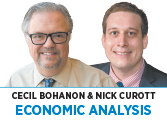Subscriber Benefit
As a subscriber you can listen to articles at work, in the car, or while you work out. Subscribe Now The Federal Reserve Bank of St. Louis posts daily the nominal interest-rate spread between the inflation-indexed and non-inflation-indexed five-year U.S. government Treasury note, which we call the FRED spread. As we have noted in previous columns, this gives us an objective market-based gauge of inflation expectations for the next five years.
The Federal Reserve Bank of St. Louis posts daily the nominal interest-rate spread between the inflation-indexed and non-inflation-indexed five-year U.S. government Treasury note, which we call the FRED spread. As we have noted in previous columns, this gives us an objective market-based gauge of inflation expectations for the next five years.
Of course, the FRED spread is not an infallible oracle of inflation. We know of no perfect predictor of future economic variables. As Yogi Berra said, “It’s tough to make predictions, especially about the future.” The inside joke among economist is, if I did have perfect information about future variables, I would certainly not tell you. After all, such information allows me to buy low and sell high. If I share this information with everyone, others will bid up the current prices and bid down the future prices, destroying my opportunity to profit!
Anyway, the five-year FRED spread has averaged 3.36% in March. It closed at 3.48% on March 18—the day the Fed officially announced it was raising rates to combat inflation. On Monday, the spread rose slightly, to 3.52%—the highest since records have been kept in 2003.
This is not good news for savers nor for the economy. With all due respect to our Keynesian colleagues, discouraging saving is bad policy.
We often ask our students what they would do if they won $10,000. Some say they’d use it to pay down loans. Some say they’d take it in $100 bills and stuff them under the mattress. Another common answer is to place it in an insured-bank certificate of deposit, or CD. A quick search indicates that insured five-year CDs are currently offering interest rates of 1.3%. So we ran some calculations assuming a 3% rate of inflation for those wanting to hold cash or CDs for five years.
$10,000 locked away in $100 bills will have purchasing power of $8,626 in March 2027. $10,000 in a bank CD maturing in March 2027 will have purchasing power of only $9,201. And that does not even include the taxes owed on the nominal interest earnings.
This is awful news. It signals a negative real return on conventional savings—hardly an encouragement for savings. It says, spend now and wait for better times to build a nest egg.
This only stokes inflation and punishes thrift. That’s not a good habit to develop—for people or the economy.•
__________
Bohanon and Curott are professors of economics at Ball State University. Send comments to [email protected].
Please enable JavaScript to view this content.
